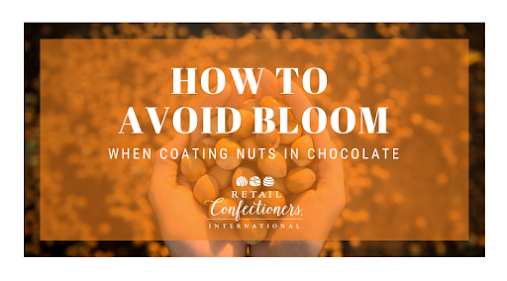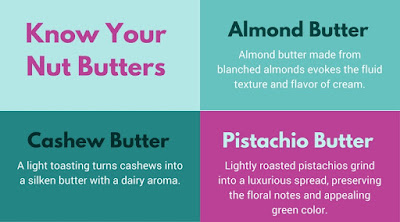|
|
Posted By RCI,
Tuesday, January 5, 2021
Updated: Thursday, January 21, 2021
|
As consumers, we love chocolate-covered nuts because they represent multiple craveable characteristics. Crunchy—check! Sweet and salty—check! Plus, as a good source of protein and healthy fats, they are often categorized as being a healthier and more satisfying treat! However, when combining nuts and chocolate in confections fat bloom often presents problems caused by oil migration. Oil migration between the chocolate and nut or nut paste leads to changes in the quality of the confection, such as visible surface bloom, hardening of the filling and softening of the chocolate.
While oil migration is inevitable when pairing chocolate and nuts together, the following techniques will help avoid or slow oil migration, pulled from past education led by Guittard Chocolate Company and the Oregon Hazelnut Marketing Board at RCI’s Fall Regional Conference in Portland, Oregon. - If using roasted hazelnuts, use a two-step roasting process.
- Select a chocolate with a fine particle size.
- Ensure the chocolate is well-tempered.
- When adding hazelnuts or hazelnut paste to tempered chocolate, the temperature of the hazelnuts should be within 1-2˚F of the temperature of the tempered chocolate.
- A thicker layer of chocolate around a hazelnut or hazelnut filling slows oil migration, bloom formation and textural change.
- Double enrobing with cooling between layers.
- Consider the shape and design of the confection to limit thin spots of coating.
- During storage, limit temperature fluctuations.
With these expert tips for fighting bloom caused by oil migration, you can create truly craveable treats using hazelnuts and other nuts. RCI members: Login at retailconfectioners.org/pasteducation to access this and other education recordings from past RCI events. Crave more? If you like what you read here, look for the "Subscribe now" box on the right to enter your email address and start receiving weekly tips, like this, delivered straight to your email inbox. RCI's Tip of the Week blog is just one of the many resources we offer to help candy makers refine their craft and build upon their business and marketing practices. Follow us on Facebook for even more sweet inspiration.
Tags:
bloom
Nuts
Oil Migration
Permalink
| Comments (0)
|
|
|
Posted By RCI,
Tuesday, April 16, 2019
Updated: Monday, April 27, 2020
|
As consumers, we love chocolate-covered nuts because they represent not one, but multiple craveable characteristics. Crunchy – check! Sweet and salty – check! Plus, as a good source of protein and healthy fats, they are often categorized as being a healthier and more satisfying treat!
However, when combining nuts and chocolate in confections oil migration often presents problems. Oil migration between the chocolate and nut or nut paste leads to changes in the quality of the confection, such as visible surface bloom, hardening of the filling and softening of the chocolate.
While oil migration is inevitable when pairing chocolate and nuts together, the following techniques will help avoid or slow oil migration, pulled from education led by Guittard Chocolate Company and the Oregon Hazelnut Marketing Board at RCI’s 2018 Fall Regional Conference in Portland, Oregon last fall.
- If using roasted hazelnuts, use a two-step roasting process.
- Select a chocolate with a fine particle size.
- Ensure the chocolate is well-tempered.
- When adding hazelnuts or hazelnut paste to tempered chocolate, the temperature of the hazelnuts should be within 1-2˚F of the temperature of the tempered chocolate.
- A thicker layer of chocolate around a hazelnut or hazelnut filling slows oil migration, bloom formation and textural change.
- Double enrobing with cooling between layers.
- Consider the shape and design of the confection to limit thin spots of coating.
- During storage, limit temperature fluctuations.
With these expert tips for fighting oil migration, you can create truly craveable treats using hazelnuts and other nuts. RCI members: Login at retailconfectioners.org/pasteducation to access this and other education recordings from past RCI events.
Crave more? If you like what you read here, look for the "Subscribe now" box on the right to enter your email address and start receiving weekly tips, like this, delivered straight to your email inbox. RCI's Tip of the Week blog is just one of the many resources we offer to help candy makers refine their craft and build upon their business and marketing practices.
Tags:
bloom
Chocolate
Chocolate-Covered Nuts
Nuts
Oil Migration
troubleshooting
Permalink
| Comments (0)
|
|
|
Posted By RCI,
Tuesday, January 9, 2018
Updated: Monday, April 27, 2020
|
Nut butter adds a healthy halo and rich toasted notes to chocolates and confections and with the prevalence of peanut allergies, many food manufacturers are exploring options beyond the mainstream.
In this excerpt taken from an article published in RCI’s Kettle Talk magazine, discover three popular nut butters to enhance your product line and how to adapt any recipe to highlight these nutrient-dense tree nuts ( RCI members: login to read full article).
There are many ways to use nut butters in modern and traditional confectionery. Use them in any recipe where a pronounced nut taste is desired, such as truffles, fudges or as a substitute for peanut butter. When combined with dairy butter, their nutty flavor is enhanced. And for vegetarian and vegan recipes, nut butters are an ideal way to mirror some of the richness of dairy butter while providing the healthfulness of a whole food.
When adapting a formula to incorporate nut butter, here are a couple points to keep in mind:
Other considerations
The standard of identity for peanut butter permits the addition of stabilizers as well as salt and sugar. Stabilizers help control the flow of any liquid fat in the peanut butter. Most natural nut butters contain neither stabilizers nor sweeteners. Because oil migration can be a concern when using nut butter confectioners may want to pay special attention to chocolate confections that are not eaten within a few weeks of production.
3 Methods to Avoid Oil Migration When Using Nut Butter:
- "When working with nut butters in a chocolate piece, select a well-refined chocolate to stem oil flow migration," recommends Julie Mates, Specialties R&D Manager, Barry Callebaut U.S.A. The finer particles in the chocolate will slow oil migration, she explains.
- A thicker coating on enrobed chocolate also acts as an oil barrier.
- When making a chocolate center with nut butter consider adding finely ground nuts, nut flour or flaked feuillantine wafers to the mixture. Not only do these ingredients contribute flavor and texture, they also help mitigate the oil migration effect.
Try something unexpected by incorporating these trendy tree nuts into your favorite confections.
Sources:
Tags:
Allergens
Candy Making
Nut Butter
Oil Migration
Permalink
| Comments (0)
|









